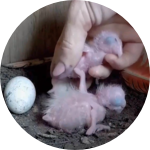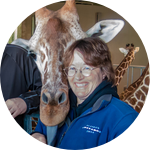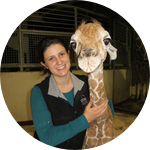About This Project
Arthritis is common in geriatric giraffe. Cheyenne Mountain Zoo is uniquely suited to help find better arthritis treatments, as we have a large herd of 16 giraffe that are trained for voluntary blood draws. Funding this project would allow us to grow stem cells from giraffe blood samples and then use stem cell therapy for a geriatric giraffe. The giraffe will be monitored with bloodwork and thermal imaging to determine if stem cells can help decrease inflammation.
Ask the Scientists
Join The DiscussionWhat is the context of this research?
Megavertebrates, including giraffe, often develop arthritis as they age. As zoo keepers and veterinarians train giraffes to participate in their own care using positive reinforcement techniques, a whole host of new treatments and therapies become a possibility. Current treatments for arthritis in giraffe include corrective hoof trims, non-steroidal anti-inflammatories, cold laser therapy, and other pain medications. Stem cells, grown from blood, are increasingly used for arthritis management in other species and the treatment could have huge potential for managing arthritis and other conditions in giraffe.
What is the significance of this project?
Current hoof trim techniques and medical management are not always enough to keep giraffe comfortable as they get older. Giraffe are long-lived, sometimes reaching age 20-30 years. Stem cell therapy has resulted in dramatic clinical improvement in some cases of arthritis in horses and other domestic species, but has not yet been attempted in giraffe. This pilot study would both identify a technique to grow stem cells from giraffe blood and would help us assess if this treatment reduces inflammation in a giraffe with advanced arthritis.
What are the goals of the project?
Our goals are to develop a protocol for growing stem cells from giraffe blood and to determine if stem cell therapy reduces inflammation in an aging giraffe. Inflammation can sometimes be measured with bloodwork changes and by measuring heat in arthritic joints, using thermography.
Cheyenne Mountain Zoo’s hope is that this research provides vets at all zoos an additional treatment option to care for giraffe. Stem cell therapy may be an important new treatment to reduce or resolve discomfort associated with arthritis in aging giraffe and other non-domestic hoof stock species. We plan to publish results so they are available to the greater accredited zoo community.
Budget
This funding would be used to grow stem cells from giraffe blood and to evaluate if these could help manage arthritis in zoo giraffe. We plan to grow the stem cell line by modifying protocols already developed for other species. In horses and other species, multiple stem cell treatments generally result in better clinical results. We plan to treat a chronically lame giraffe that is already trained for blood collection and hoof trims, yet continues to have lameness despite medical management. To determine that the treatment reduces inflammation, we will monitor bloodwork both before and after each of 3 stem cell treatments. Additionally, we will assess if there is a visible change in the giraffe's lameness and use our thermal imaging camera to quantify if the treatment has any effect on joint inflammation.
Endorsed by
Meet the Team
Affiliates
Team Bio
Our team brings together a zoo vet with demonstrated expertise managing giraffe orthopedic issues plus a regenerative medicine veterinarian who has already grown stem cells for multiple non-domestic species. In the last year, we have worked together to better manage arthritis and lameness in a geriatric elephant by treating her with a stem cell line grown from the elephant's blood. In that case, we have observed dramatic clinical improvement and our publication is in preparation.
Liza Dadone
I am a vet at the Cheyenne Mountain Zoo, where I have worked with one of the largest giraffe herds in North America for the past six years. Because of our award winning giraffe training program, I have unprecedented hands-on access to our 16 giraffe. This has helped us develop techniques to better manage arthritis and other conditions in giraffe. I have presented on our giraffe medical care at multiple national and international conferences, and our Zoo now hosts an annual Giraffe Care Workshop to help advance giraffe medicine. My hope is that by keeping zoo giraffe healthy and happy with advances in veterinary care, our guests will have more opportunities to interact and fall in love with these beautiful creatures.
In the past few years, I have also become involved with giraffe conservation. Wild giraffe are having a "silent crisis" in that their populations have decreased by about 40% in 30 years and yet this receives relatively little media attention. A career highlight for me was helping with a Rothschild's giraffe conservation project earlier this year, called "Operation Twiga." I was part of a multinational team that captured 18 wild giraffe and moved them by boat across the Nile River, back into their historic home range. This was done because almost all of this subspecies (1,500 giraffe) live in a park where oil mining is about to begin and will likely impact that ecosystem. The project was featured in the PBS documentary Giraffes: Africa's Gentle Giants http://www.pbs.org/video/23658...(I'm the vet in the blue Zoo shirt).
By working with both zoo and wild giraffe, my hope is to help both groups and ultimately to make giraffe conservation more effective. Zoo vet expertise could be invaluable for diagnosing and managing wild giraffe health problems such as Giraffe Skin Disease. Likewise, understanding if there are differences in foot shape for wild vs zoo giraffe could help us find ways to manage zoo giraffe differently and ideally prevent arthritis.
Valerie Johnson
I am a critical care veterinarian and postdoctoral research fellow at the Colorado State University Veterinary Teaching Hospital. In addition, I am a part-time staff veterinarian at the Wild Animal Sanctuary. Over the past five years, I have been working in regenerative medicine utilizing mesenchymal stem cells (MSC) as a therapeutic modality for various disease processes including multidrug resistant infections, immune mediated disease and arthritis. We recently conducted a trial in dogs with severe arthritis using force plate gait analysis and examining joint fluid to evaluate their pain before and after intravenous MSC inections. These dogs were treated with 3 injections of adipose derived MSC from unrelated donors. No adverse effects were noted in any animal and all dogs were reported to improve substantially even after withdrawal from nonsteroidal anti-inflammatory medications for the 6 month period of observation (publication in progress).
Regenerative medicine is a promising new avenue for treatment of chronic age related degenerative diseases. I have safely treated several species with cells grown in the laboratory including a mountain lion, tiger, wolf, coyote and an elephant. We have successfully modified a protocol utilized in other species to grow MSC from blood and are confident that this procedure could be used for multiple species precluding the necessity for sedation and a surgical procedure.
I am interested in advancing medical care for species which currently have limited therapeutic options and investigating the potential of regenerative medicine in these animals. I believe my experience in regenerative medicine and working with cells from multiple different species puts me in a unique position to develop more efficient and effective methods for treating these valuable animals.
Additional Information
We previously have done trained radiographs (x-rays) of all our giraffe to diagnose arthritis. Thermal imaging allows us to then identify and quantify physiologically significant inflammation associated with those arthritis lesions. In this study, we will measure joint temperatures before and after stem cell treatments to determine if the therapy helps reduce inflammation.
Project Backers
- 122Backers
- 130%Funded
- $5,476Total Donations
- $44.52Average Donation




